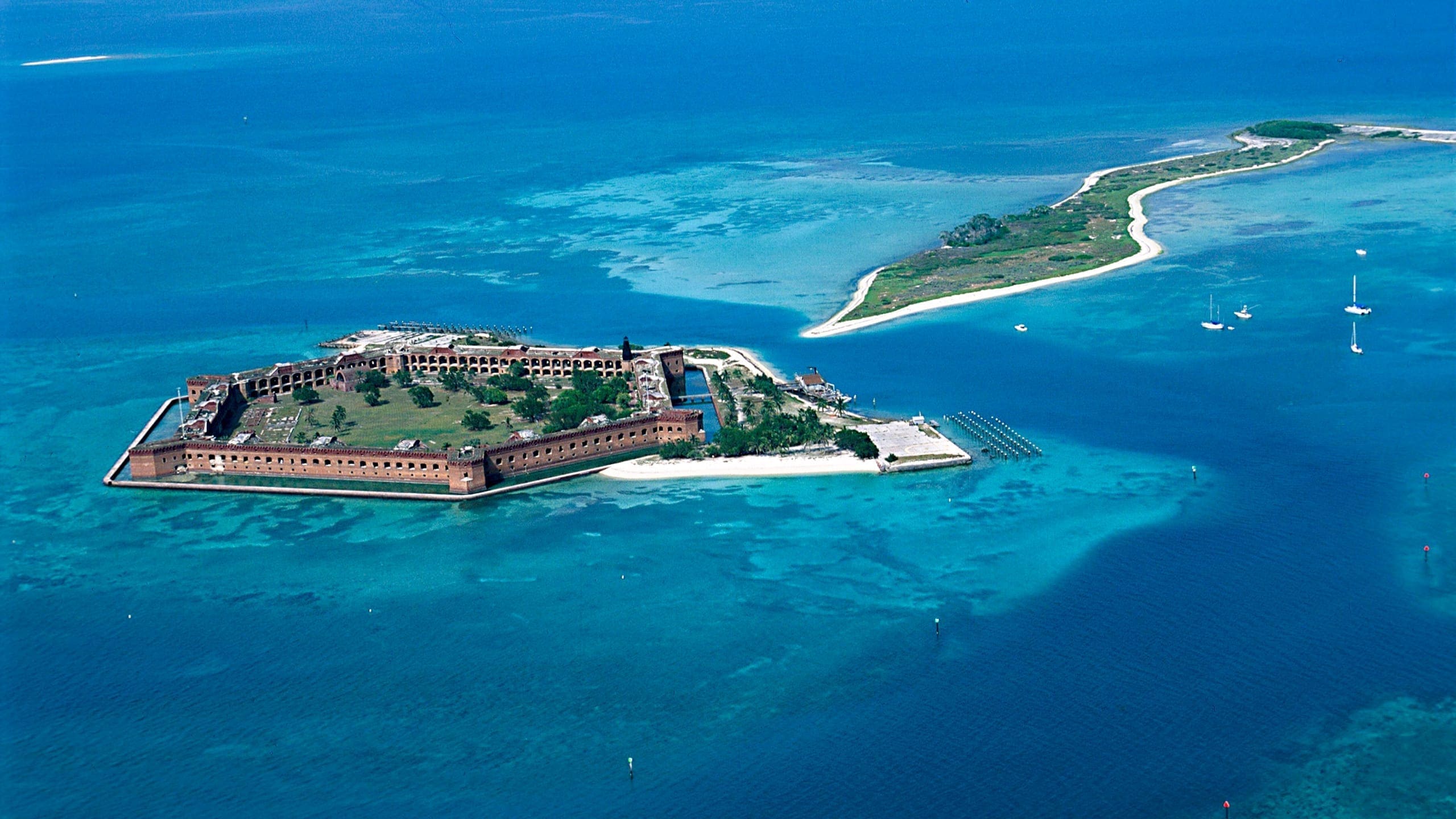About Dry Tortugas National Park
Dry Tortugas National Park is approximately 70 miles west of Key West in the Straits of Florida, and consists of roughly 101 square miles at the westernmost extent of the Florida Keys. The Florida Keys are composed of 1,700 keys, or islands. The park currently encompasses seven keys, including Garden, Loggerhead, Bush, Long, East, Hospital, and Middle Keys, collectively known as the Dry Tortugas. The keys are composed of coral reefs and sand and are surrounded by shoals and open water. Due to the effects from wind, waves, and storms, these islands are constantly changing in shape, size, and elevation. In fact, historically, hurricanes have caused a few of the smaller keys to disappear and reappear due to sandbar movement.
At present, only Garden and Loggerhead Keys possess known elements of human habitation and development. In a global context, the Dry Tortugas are situated at the edge of the main shipping channel between the Gulf of Mexico, the western Caribbean, and the Atlantic Ocean. Thus, these keys were of strategic importance for national defense, and the underwater reefs have posed a serious navigation hazard to passing ships over the centuries, creating a submerged cultural landscape containing numerous shipwrecks and making this area one of the nation’s principal ship graveyards.
Under the authority of the Antiquities Act, President Franklin D. Roosevelt designated Fort Jefferson National Monument on January 4, 1935, and assigned management responsibilities to the National Park Service. This national monument included 47,000 acres of keys and water and primarily focused attention on the historic fort on Garden Key. Congress expanded the monument in 1983 and redesignated it as Dry Tortugas National Park on October 26, 1992. Upon redesignation, the unit’s purpose broadened to emphasize not only Fort Jefferson and the many shipwrecks and other cultural resources in the park, but also the preservation of the diverse island and marine ecosystems of the Dry Tortugas. Due to its remote location, the park is accessible by commercial ferry boat, seaplane, or private boat. Visitors experience the park through recreational activities such as touring Fort Jefferson, snorkeling, scuba diving, paddle boarding, sea kayaking, camping, bird-watching, boating, and recreational fishing.
Garden Key is the site of Fort Jefferson, one of the most ambitious and expansive 19th century American masonry coastal forts. Originally built to protect shipping access to the Gulf of Mexico, construction began in 1846 but was never completed. Logistical challenges and the Civil War delayed construction. During the Civil War, the fort was used as a military prison, housing Union deserters and four Lincoln assassination conspirators. The fort was never completed due to shifting military technologies and its construction ceased in 1875. Today, Fort Jefferson is the primary destination for people visiting the park and remains an iconic image of the permanent Third System coastal defense era.
Loggerhead Key is the largest of the seven keys and home to the Dry Tortugas Light Station, which was completed in 1858. Standing at over 160 feet in height, the light station provided warnings to sea vessels of the dangerous reefs of the Dry Tortugas and was operated by the U.S. Coast Guard until 2014. Also on Loggerhead Key are the ruins of the first subtropical marine laboratory in the Western Hemisphere—the Carnegie Institution Tortugas Marine Biology Laboratory, which was established in 1904.
The five other keys in the park remain in a relatively natural state and are managed to protect the critical habitat they provide. Hospital and Long Keys possess significant turtle and bird nesting sites and are closed to visitation year-round. Bush Key is closed part of the year during bird nesting season. Middle Key is a sandbar that is awash in the summer but emerges intermittently at other times of the year. East Key is also a significant turtle nesting area and is closed during the nesting/hatching period.
The keys in the park account for less than one-fifth of a square mile of the park’s 101 square miles. Dry Tortugas National Park protects a rich biodiversity of coastal and marine life, including seagrass beds, diverse fisheries, and high-quality sea turtle and bird nesting habitat. In addition, the subtropical coral reefs of the Dry Tortugas are some of the most pristine on the continent and possess a full range of Caribbean coral species. The park’s designated no-take research natural area protects spawning habitat that supports healthy fish populations and a diversity of other aquatic species that spread to other areas of the Straits of Florida and beyond by swimming or by the flow of currents that disperse larvae to distant areas, resulting in benefits to regional fisheries far beyond the park’s boundary. These resources play a vital role in sustaining Florida’s coastal ecosystems and fisheries. The research natural area was also established to complement the marine preservation provided by the adjacent Tortugas Ecological Reserve, which is managed by National Marine Sanctuaries, a branch of the National Oceanic and Atmospheric Administration.
Source: Foundation Document – Dry Tortugas National Park
Fast Facts:
| Date the Park was Established: | October 26, 1992 |
| Park Area (as of 2019): | 64,701.22 acres (261.8 km2) |
| Recreational Visitors (2018 Total): | 56810 visitors |

